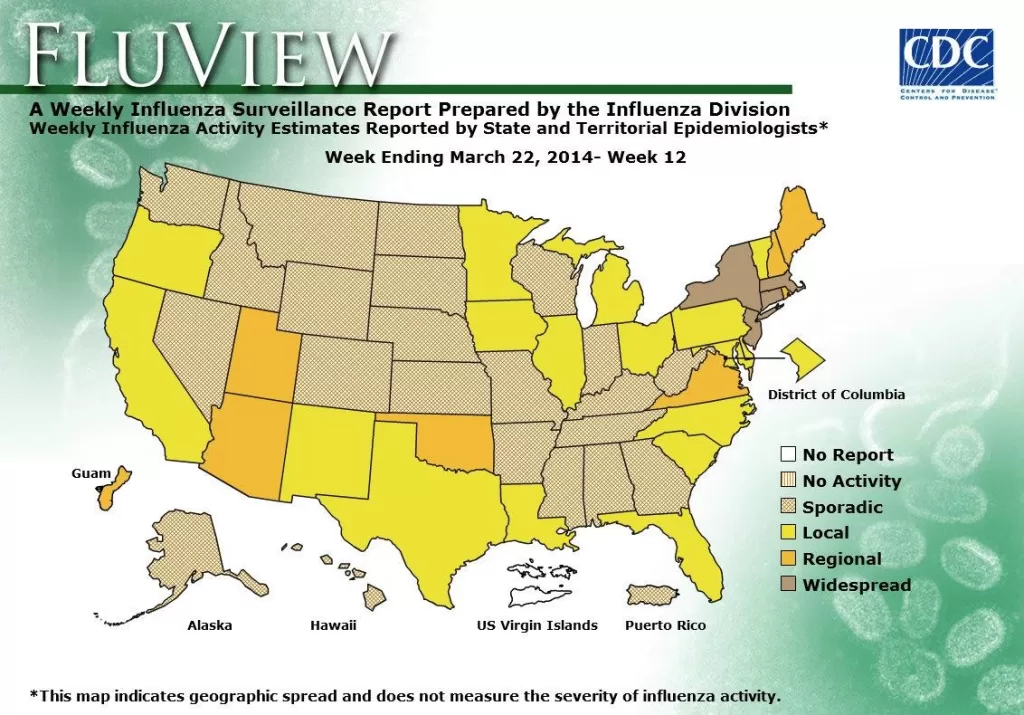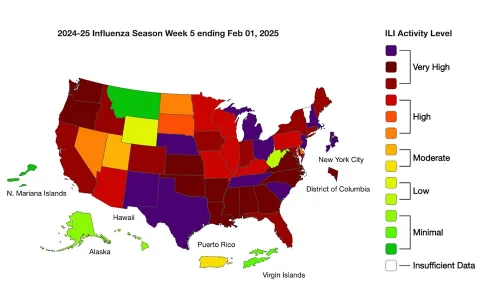US flu activity is currently experiencing a notable surge, with alarming trends reported by the Centers for Disease Control and Prevention (CDC). Over the past week, 44 states have documented high or very high influenza rates, showcasing an increase in flu cases rise across the nation. Recently released data indicates a test positivity rate nearing 30%, signaling a concerning level of transmission. Pediatric flu deaths have also seen a spike, with the CDC recording 16 new fatalities among children, pushing the season’s total to 47. As influenza A strains like H3N2 and H1N1 dominate the circulating viruses, health officials continue to monitor flu hospitalization rates as emergency department visits for flu-like symptoms escalate significantly.
The ongoing rise in influenza prevalence within the United States has become a pressing public health concern as we witness debilitating effects on communities, particularly among younger populations. This notable uptick in cases corresponds with alarming reports of child fatalities attributed to the virus. The alarming data highlights the spread of dominant strains of the virus, particularly influenza A, underscoring the importance of vigilance against respiratory illnesses. As hospital visits soar, especially in emergency departments, concerns regarding the overall impact of seasonal illnesses are increasing. In light of these developments, health organizations urge prompt action and awareness to mitigate the effects of this year’s influenza season.
Current US Flu Activity Trends
The recent surge in US flu activity has captured the attention of health officials, with 44 states experiencing high to very high levels of the virus. According to the latest CDC flu report, test positivity rates are hovering just below 30%, indicating a significant increase in flu cases. For nine consecutive weeks, outpatient visits for flu-like symptoms have exceeded the national baseline, highlighting an urgent public health concern. As we move deeper into the flu season, the overwhelming presence of influenza A strains, particularly H3N2 and 2009 H1N1, raises alarms not only for adults but also for vulnerable populations, such as children and the elderly, who are at higher risk for severe outcomes.
Geographic distribution shows alarming rates of flu activity across much of the country. The CDC’s flu activity mapping illustrates that several states, especially in the Southeastern and Northeastern regions, are shaded in darker tones of red, indicating critically high flu prevalence. As more regions report increasing illness rates, the potential strain on healthcare systems may escalate, emphasizing the importance of preventive measures, including vaccination and public awareness campaigns. The combined pressure from COVID-19 and RSV further complicates the healthcare landscape, necessitating ongoing monitoring and timely interventions.
Pediatric Flu Deaths and Their Impact
A troubling rise in pediatric flu deaths has been reported, with the CDC confirming an additional 16 fatalities, pushing the season’s toll to 47. This season, all reported pediatric deaths occurred due to influenza A infections, underscoring the significant risks associated with this viral strain among younger populations. With an alarming number of these cases involving both H1N1 and H3N2 subtypes, the situation calls for vigilant monitoring and targeted responses to mitigate further losses in this vulnerable demographic. Parents and caregivers are urged to remain alert for flu symptoms and seek medical advice promptly.
The increase in pediatric flu deaths highlights the necessity for improved public health strategies targeting flu prevention among children. Emergency department visits for flu-related illnesses have surged, constituting a significant proportion of all ED visits. This trend emphasizes the need for heightened awareness, especially during peak flu season, where timely vaccination can be a lifesaving measure. As more children face higher hospitalization rates, community resources and support systems should focus on educating parents about the signs of flu and the importance of vaccination to protect young children.
Surging Flu Hospitalization Rates
Flu-related hospitalizations have surged, affecting all age groups but particularly impacting the pediatric population. The CDC’s recent data indicates that an increasing number of hospitalizations are being recorded, averaging around 7% of all emergency department visits across the nation. With peak hospitalization rates correlated with heightened flu activity, healthcare providers are concerned about the flow of patients as cases continue to rise. The need for integrated healthcare responses to manage increasing flu hospitalization rates is critical at this juncture.
The overall strain on hospital resources becomes evident as flu hospitalization rates escalate, with healthcare providers calling for immediate action to manage patient care effectively. Collaborative efforts between hospitals, public health officials, and community organizations are essential in preparing for an influx of patients, ensuring adequate care while also promoting public health measures such as vaccination clinics and flu education campaigns. As the flu strains continue to evolve, so too must our strategies for prevention and care.
The Role of Influenza A Strains in Current Outbreaks
The predominant circulating subtype during this flu season has been influenza A, particularly the H3N2 and 2009 H1N1 strains. Understanding the characteristics and behaviors of these strains is vital for formulating effective treatment and prevention strategies. The CDC has documented that nearly all samples testing positive for flu are type A, indicating their significant role in the current outbreaks. This trend necessitates health authorities to adapt their vaccination recommendations and focus resources on combating these specific strains, which have demonstrated a capacity for utility in increasing hospitalization rate among diverse age groups.
Moreover, the genetic variability of influenza A strains presents ongoing challenges in managing flu outbreaks. The nuanced understanding of these strains helps healthcare professionals discern patterns that might predict waves of flu activity, potentially aiding in better vaccine formulation strategies for upcoming seasons. Active surveillance and research efforts must focus on identifying changes in viral behavior to mitigate the impact of influenza A on public health and guide public awareness campaigns effectively.
Recommendations From the CDC Regarding Flu Preparedness
The CDC has emphasized the importance of flu preparedness as case numbers continue to rise. With over 44 states currently reporting high flu activity, the Centers for Disease Control and Prevention encourage everyone, especially vulnerable populations, to receive their flu vaccinations. The vaccination not only protects individuals but also helps curb the spread of the virus within communities. Furthermore, it is highly recommended that people practice basic hygiene measures, such as frequent hand washing and avoiding close contact with those who are sick, to further reduce transmission rates.
In addition to vaccinations, the CDC suggests keeping an updated inventory of flu treatments and medications at home to manage symptoms efficiently should flu infection occur. For those who do contract the flu, timely medical consultation is crucial. Healthcare providers are advised to remain vigilant in monitoring flu cases, especially during notable outbreaks, to ensure rapid response levels are maintained and strain on healthcare systems remains manageable.
Understanding the Flu Season Dynamics
Understanding the dynamics of the flu season is crucial for effective public health strategies. The flu season typically peaks during the winter months, which coincides with increased indoor activity and close contact among individuals. This interplay has resulted in a periodic surge in flu cases, as evidenced by the current spike with nearly 30% positivity in flu tests. By recognizing pattern surges associated with seasonal changes, public health officials can better prepare healthcare facilities and communities for potential outbreaks.
In addition, analyzing the trends and data from previous flu seasons assists in creating predictive models that can forecast future surges. By examining factors such as humidity, temperature, and social behaviors during various months, public health leaders can implement preemptive strategies to minimize the impact of the flu. This kind of proactive approach can help direct resources to areas most affected and ensure preventive measures are enacted timely.
Monitoring Additional Respiratory Illnesses
In the context of rising flu cases, it’s also important to monitor other respiratory illnesses, including COVID-19 and RSV, which share similarities in symptoms and transmission patterns. The CDC has reported a stabilization in COVID-19 hospitalization levels but highlights a need for continuous monitoring as wastewater detections indicate fluctuations in virus levels. Concurrently addressing these respiratory illnesses allows for more comprehensive public health initiatives, ensuring resources are allocated effectively and healthcare facilities remain equipped to handle multiple outbreaks simultaneously.
With the combination of these respiratory viruses, healthcare providers find themselves at a crossroads, managing effectively amidst potentially overlapping outbreaks. Community health education campaigns play a crucial role in disseminating information about differentiating symptoms and suggested actions should individuals fall ill. This needs to be paired with broader testing strategies, making it vital for individuals to be aware of the respiratory health landscape during the season.
Vaccination and Its Importance in School Settings
With the flu season in full swing, schools represent a critical focal point for vaccination efforts, especially as children tend to spend significant time in close quarters. The CDC advocates for flu vaccinations as a significant protective measure reducing the risk of illness in school populations. By developing school-based vaccination programs, public health officials can heighten flu prevention efforts, minimizing the dramatic impact of flu outbreaks on attendance and overall community health.
Moreover, educating parents about the importance of flu vaccination in children can bolster participation rates and overall effectiveness. School systems should collaborate with local health departments to facilitate flu shot clinics, providing easy access to vaccinations for both students and staff. By fostering a culture of health and wellness in schools, we not only protect children and their families but also reduce broader transmission rates within the community.
The Future of Flu Surveillance and Response
As flu activity continues to evolve, so too must our approaches to surveillance and response. Enhanced surveillance systems that utilize real-time data are becoming increasingly important to track flu patterns and outbreaks effectively. The integration of technology, including digital health tracking and reporting mechanisms, can significantly improve the ability to forecast flu trends and respond swiftly to any spikes in activity.
Looking forward, investing in research and public health infrastructure development will be critical in managing flu-related challenges. Continuous improvement in flu vaccination technology, such as universal flu vaccines, offers promise for more effective long-term solutions. By embracing innovation in health surveillance and vaccination strategies, we can better prepare for fluctuations in flu patterns and ultimately protect public health more effectively.
Frequently Asked Questions
What recent trends are being reported regarding US flu activity?
Recent trends reveal a notable rise in US flu activity, with 44 states reporting high or very high levels of influenza cases. According to the CDC, nearly 30% of flu tests are coming back positive, and outpatient visits for flu-like illnesses have exceeded national baselines for nine consecutive weeks.
How many pediatric flu deaths have been reported this season in the US?
This flu season, the CDC has reported a total of 47 pediatric flu deaths, with 16 additional deaths reported in the latest update. All pediatric deaths this season involved influenza A, primarily in the H1N1 and H3N2 strains.
What strains of influenza are currently prevalent in the US flu activity?
In the current US flu activity, nearly all detected cases are of influenza A strains. The CDC indicates that among these, approximately half are the H3N2 strain and the other half are 2009 H1N1, contributing to the rising flu hospitalization rates.
What does the CDC’s flu report indicate about hospitalizations related to flu activity?
The CDC’s latest flu report highlights that flu-related hospitalizations remain elevated across all age groups, continuing the upward trend in flu activity. Emergency department visits for flu demonstrate significant increases, now constituting about 7% of all ED visits.
Which regions in the US are experiencing the highest levels of flu activity?
High levels of flu activity are reported nationwide, especially in Southeastern states like Louisiana and South Carolina, and in Northeastern states including Massachusetts and New York. The CDC’s activity map shows most areas shaded red or purple, indicating very high flu activity.
| Key Points | Details |
|---|---|
| Overall Flu Activity | The flu activity is rising across the U.S. with 44 states reporting significant levels. |
| Positive Tests | Test positivity for flu is nearing 30%, with influenza A being the predominant strain. |
| Pediatric Deaths | An additional 16 pediatric deaths have raised the total to 47 this season due to influenza A. |
| ED Visits for Flu | Flu-related ED visits constitute 7% of all visits, indicating widespread impact. |
| Hospitalizations | Flu-related hospitalizations are increasing across all age groups, remaining elevated. |
| RSV and COVID Stats | RSV is declining, while COVID-19 remains stable but with high hospitalizations among seniors. |
Summary
US flu activity has seen a significant rise in recent weeks, leading to heightened concerns about public health. With high levels of flu reported in 44 states and an alarming number of pediatric deaths, the situation is critical. It’s essential for the public to stay informed and take necessary precautions to mitigate the spread of the virus.
The content provided on this blog (e.g., symptom descriptions, health tips, or general advice) is for informational purposes only and is not a substitute for professional medical advice, diagnosis, or treatment. Always seek the guidance of your physician or other qualified healthcare provider with any questions you may have regarding a medical condition. Never disregard professional medical advice or delay seeking it because of something you have read on this website. If you believe you may have a medical emergency, call your doctor or emergency services immediately. Reliance on any information provided by this blog is solely at your own risk.








